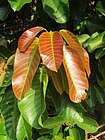Note: This is a project under development. The articles on this wiki are just being initiated and broadly incomplete. You can Help creating new pages.
Vateria indica - Ajakarna, Piney
Vateria indica is a species of plant in the dipterocarpaceae family. It is endemic to India. It is threatened by habitat loss. This tree grows like a palm but has blunt thorns along its trunk.
Uses
Bloaitng, Abdominal pain, Gout, Neck stiffness, Skin eruptions, Locked jaw paralysis, Pimples, Diarrhea, Sore throats
Parts Used
Chemical Composition
Bark contains Dl-epicatechin, fischinidol and afzetechin. Tree yields a resin which is a complex mixture of triterpenes. Seeds yield semi solid fat known as Piney tallow or Malabar tallow. Fruit shell yields tannins. Gum yields lipids.[1]
Common names
| Language | Common name |
|---|---|
| Kannada | ಬಿಳಿ ಡಾವರು Bili daamaru, ಬಿಳಿ ಧೂಪ Bili dhupa |
| Hindi | Safed daamar |
| Malayalam | Baine, Kunturukkam |
| Tamil | Dhupa maram |
| Telugu | Tellaguggilamu |
| Marathi | Chandrusa |
| Gujarathi | NA |
| Punjabi | NA |
| Kashmiri | NA |
| Sanskrit | NA |
| English | Indian copal tree, Indian gum anime |
Properties
Reference: Dravya - Substance, Rasa - Taste, Guna - Qualities, Veerya - Potency, Vipaka - Post-digesion effect, Karma - Pharmacological activity, Prabhava - Therepeutics.
Dravya
Rasa
Tikta (Bitter), Kashaya (Astringent)
Guna
Snigda (unctuous)
Veerya
Sheeta (cold)
Vipaka
Katu (Pungent)
Karma
Kapha, Vata
Prabhava
Habit
Identification
Leaf
| Kind | Shape | Feature |
|---|---|---|
| Simple | Alternate | Leaves are spiral; stipules caducous; petiole 2-3.5 cm, swollen at apex, nearly glabrous |
Flower
| Type | Size | Color and composition | Stamen | More information |
|---|---|---|---|---|
| Unisexual | 2-4cm long | White | 5-20 | Inflorescence axillary panicles with dense stellate hairs |
Fruit
| Type | Size | Mass | Appearance | Seeds | More information |
|---|---|---|---|---|---|
| Capsule | 6.4 x 3.8 cm | 3-valved, calyx persistent, reflexed | With hooked hairs | - | {{{6}}} |
Other features
List of Ayurvedic medicine in which the herb is used
Where to get the saplings
Mode of Propagation
How to plant/cultivate
A tree of low to moderate elevations in the moist, monsoonal tropics, where it can be found at elevations up to 1,200 metres[4]
Commonly seen growing in areas
Photo Gallery
References
External Links
- Ayurvedic Herbs known to be helpful to treat Bloaitng
- Ayurvedic Herbs known to be helpful to treat Abdominal pain
- Ayurvedic Herbs known to be helpful to treat Gout
- Ayurvedic Herbs known to be helpful to treat Neck stiffness
- Ayurvedic Herbs known to be helpful to treat Skin eruptions
- Ayurvedic Herbs known to be helpful to treat Locked jaw paralysis
- Ayurvedic Herbs known to be helpful to treat Pimples
- Ayurvedic Herbs known to be helpful to treat Diarrhea
- Ayurvedic Herbs known to be helpful to treat Sore throats
- Herbs with Seeds used in medicine
- Herbs with Bark used in medicine
- Herbs with common name in Kannada
- Herbs with common name in Hindi
- Herbs with common name in Malayalam
- Herbs with common name in Tamil
- Herbs with common name in Telugu
- Herbs with common name in Marathi
- Herbs with common name in English
- Habit - Herb
- Index of Plants which can be propagated by Seeds
- Index of Plants which can be propagated by Cuttings
- Herbs that are commonly seen in the region of West coastal evergreen forest
- Herbs that are commonly seen in the region of Secondary evergreen forest
- Herbs
- Dipterocarpaceae








